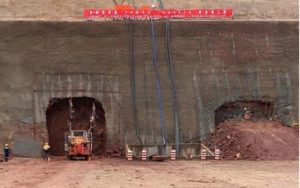Friedland’s Ivanhoe Mines issues clarification on DRC mining code

Drilling support holes for the Kakula service decline at the Ivanhoe Mines Kamoa-Kakula copper project in the Democratic Republic of Congo. Source: Ivanhoe Mines Ltd.

Investors continued to bail out of Ivanhoe Mines Ltd. [IVN-TSX; IVPAF-OTC] on Thursday February 1, even after the company issued a press release saying it is aware of media reports regarding “possible changes” to the mining code in the Democratic Republic of Congo (DRC).
“Ivanhoe notes that there have been no changes implemented into law,” the company said in a press release, adding that it plans to issue a further statement in the near future.
However, that didn’t prevent the shares from falling another 6.5% to $3.29 on Thursday. The stock was down 11% on January 31, 2018 after DRC lawmakers voted in favour of new mining laws.
Shares of DRC-focused mining companies are under pressure following reports by Bloomberg news service and others that lawmakers in the DRC have canceled contract guarantees and hiked a key royalty. The measures are part of mining law reforms that are expected to have an immediate financial impact on every mining project in the country.
Sweeping amendments to the revised mining law were passed by the DRC parliament on January 27, 2018. They are expected to raise the cost of doing business in the DRC, which ranks as Africa’s largest copper producer and the world’s largest source of cobalt, while boosting the state’s share of mining revenue. The previous law passed in 2002 exempted license holders from changes to fiscal and custom regimes for 10 years.
As a result, companies like Swiss metals giant Glencore AG, Rangold Resources Ltd. and Ivanhoe will immediately be subjected to higher royalties on metals, including copper, cobalt and gold, as well as a new 50% tax on so-called super profits, reports say. The so-called super profits are defined as income that is realized when commodity prices rise 25% above levels included in the project’s bankable feasibility study.
As well, the new mining code permits the DRC to raise the royalty on cobalt to 10% from 2% should the government decide that the mineral is a strategic substance.
Cobalt, which is often produced as a by-product of copper and nickel, and sometimes occurs with silver, has recently become a much sought after commodity due to its key role in the production of rechargeable batteries used in the manufacture of electric vehicles.
Ivanhoe Mines, headed by billionaire financier Robert Friedland, is advancing its three principal projects in South Africa, including:
- Mine development at the Platreef platinum-palladium-gold-nickel copper discovery on the Northern Limb of South Africa’s Bushveld Complex.
- Mine development and exploration at the Tier One Kamoa-Kakula copper discovery on the Central African Copperbelt in the DRC.
- Upgrading at the historic, high-grade Kipushi zinc-copper-silver-germanium mine, which is also located on the DRC’s Copperbelt.
A prefeasibility study for Kipushi is forecasting life-of-mine average annual planned zinc concentrate production of 381,000 tonnes per annum, with a concentrate grade of 59% zinc. Total zinc production is expected to be 8.6 million tonnes of ore at 32.14% zinc over a period of 11 years to produce 2.5 million tonnes of zinc metal in concentrate.
